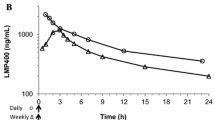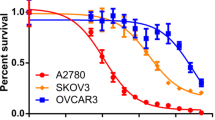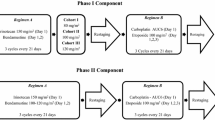Abstract
Topotecan (TPT) is a DNA-Topoisomerase I poison that exhibitsantitumor activity. TPT, like other DNA-damaging agents, arrests ordelays cell cycle progression during S- and G2-phase in a widevariety of tumor-derived cell lines. Particularly, the G2-arrest gives time for the cell to repair its DNA lesions prior tostarting a new cell cycle. Based on these observations, we assessedthe interaction between TPT and G2/M-active agents in p53–mutatedcell lines of diverse origin in order to achieve cell toxicity. Two short-term sequential schedules were administered(TPT → G2/M-active drug at the interval of greatest TPT-inducedG2/M-phase cell arrest, and G2/M-active drug → TPT), in threehuman tumor-derived cell lines with proven sensitivity to the following drugs: Bleomycin in HEp-2 (squamous larynx carcinoma);Docetaxel in SKBr-3 (breast adenocarcinoma); Etoposide in NCI-H23(non-small-cell lung cancer). Our results show that: 1) SequentialTPT → G2/M-active drugs are synergistic when administrationoverlapped the maximum percentage of TPT-induced G2/M–phase cellarrest interval in all three mutated p53 cell lines; 2) the reversesequential schedule (G2/M-active drug → TPT) was antagonistic,and being only additive for Etoposide → TPT association. Inconclusion, our findings further support the potential cytotoxicrole of TPT in combination with other active drugs when the correctschedule of administration is applied. In addition, they provide arationale for new applications in clinical trials using short-termsequential TPT → G2/M-active drugs.
Similar content being viewed by others
References
Dancey J, Eisenhauer E: Current perspectives on camptothecins in cancer treatment (Editorial). Br J Cancer 74: 327–338, 1996
Donehower RC, Kaufmann SH: The current status of camptothecin analogues as antitumour agents. J Natl Cancer Inst 85(4): 221–291, 1993
Li LH, Fraser TJ, Olin EJ, Bhuyan BK. Action of camptothecin on mammalian cells in culture. Cancer Res 32: 2643–2650, 1972
Johnson E, Fridborg H, Csóka K, Sundstrom C, Nygren P, Larsson R: Cytotoxic activity of Topotecan in human tumour cell lines and primary cultures of human tumour cells from patients. Br J Cancer 76(2): 211–219, 1997
Holm E, Lovey JM, Kerrigan D, Pomier Y: Differential requirement of DNA replication for the cytotoxicity of DNA topoisomerase I and 11 in Chinese hamster DC3F cells. Cancer Res 49: 6365–6368, 1989
Burris HA, Hanauske, A, Johnson F, Marshall M, Khun J, Hilsenbeck SE, Von Hoff DD: Activity of topotecan, a new topoisomerase I inhibitor against human colony-forming units in vitro. J Natl Cancer Inst 84: 1816–1819, 1992
Perez-Soler R, Fosella F, Glisson B, Lee J, Murphy W, Shin D, Kemp BL, Lee JJ, Kave J, Robinson RA, Lippman SM, Kurie JM, Huber W, Raber MN, Hong WK: Phase 11 study of topotecan in patients with advanced non-small cell lung cancer previously untreated with chemotherapy. J Clin Oncol 14: 503–513, 1996
Uckun FM, Stewart CF, Reaman G, Chelstrom LM, Jin J, Chandan-Langlie M, Waddick KG, White J, Evans WE: In vitro and in vivo activity of topotecan against human B-lineage acute lymphoblastic leukemia cells. Blood 85: 2817–282, 1995
Creemers GJ, Bolis G, Gore M, Scarfone G, Lacave AJ, Guastalla JP, Despax R: Topotecan an active drug in the second-line treatment of epithelial ovarian cancer: results of large European phase H study. J Clin Oncol 14: 3056–3061, 1996
Hsiang YH, Hertzberg F, Hecht S, Liu LF: Camptothecin induces protein-linked DNA breaks via mammalian DNA topoisomerase 1. J Biol Chem 260: 14873–14878, 1985
Kaufmann S, Peereboom D, Buckwalter CA, Svingen PA, Grochow LB, Donehower RC, Rowinsky EK: Cytotoxic, effects of Topotecan combined with various anticancer agents in human cancer cell lines. J Natl Cancer Inst 88 (11): 734–741, 1996
Hsiang YK, Lihon MG, Liu LF: Arrest of replication forks by drug-stabilized Topoisomerase I-DNA cleavable complexes as a mechanism of cell killing by camptothecin. Cancer Res 49: 5077–5082, 1989
D'Arpa P, Beardmore C, Liu LF: Involvement of nucleic acid synthesis in cell killing mechanisms of Topoisomerase Poisons. Cancer Res 50: 6919–6924, 1990
Champoux J: Evidence for a intermediate with a single-strand break in the reaction catalysed by DNA untwisting enzyme. Proc Natl Acad Sci (USA) 73: 384–391, 1976
Shinka BK: Topoisomerase inhibitors. A review of their therapeutic potential in cancer. Drugs 49: 11–19, 1995
Goldwasser F, Shimizu T, Jackman J, Hoki Y, O'Connor PM, Kohn KW, Pommier Y: Correlation between S and G2 arrest and the cytotoxicity of Camptothecin in Human Colon Carcinoma Cells. Cancer Res 56: 4430–4037, 1996
Del Bino G, Skiersky TS, Darzynkiewiz Z: Diverse effects of camptothecin an inhibitor of topoisomerase I on the cell cycle (L210, MOLT4) and myelogenous (HL60, KGI) leukemic cells. Cancer Res 50: 2746–2750, 1990
Slichenmeyer WJ, Rowinsky EK, Donehower RC, Kaufmann SH: The current status of camptothecin analogues as anticancer agents. J Natl Cancer Inst 85: 271–287, 1993
Yeou-Ping Tsao, D'Arpa P, Liu LF: The involvement of active DNA synthesis in Camptothecin-induced G2 arrest: altered 147 regulation of p34cdc2 / cyclin B1. Cancer Res 52: 1823–1829, 1992
Shao R, Cao C, Shimizu T, O'Connor PM, Kohn KW, Pomier Y: Abrogation of an S-phase checkpoint and potentiation of Camptothecin cytotoxicity by 7-Hydroxistausporine (UCN-01) in human cancer cell lines, possibly influenced by p53 function. Cancer Res 57: 4029–4035, 1997
Barlogie B, Drewinko B: Cell cycle stage-dependent induction of G2-phase arrest by different antitumour agents. Eur J Cancer 14: 741–745, 1978
Stewart N, I-Ecks GE, Paraskevas F, Mowat M: Evidence for a second cell cycle block at G2/M by p53. Oncogene 10: 109–115, 1995
Skladanowski A, Larsen AK: Expression of a wild-type p53 increases Etoposide cytotoxicity in M1myeloid leukemia cells by facilited G2 to M transition: implications for gene therapy. Cancer Res 57: 818–823, 1997
Lowe SW, Ruley BE, Jacks T, Housman DE: p53-dependent apoptosis modulates the cytotoxicity of anticancer agents. Cell 74 (6): 957–967, 1993
Fan S, Smith ML, Rivet DJ, Duba D, Zahn Q, Kohn KW Fornace AJ Jr, O'Connor PM: Disruption of p53 function sensitizes breast cancer MCF-7 cells to cis-platin and pentoxyfilline. Cancer Res 55: 1643–1648, 1995
Ferreira CG, Tolis, C, Giaccone G. p53 and chemosensitivity. Ann Oncol 10: 1011–1021, 1999
Sikic BI: Biochemichal and cellular determination of Bleomycin cytotoxicity. Cancer Surv 5: 81–96, 1988
Povirk LF, Wübker W, Köhnlein W, Hutchinson F: DNA double-strand breaks and alkali-labile bonds produced by Bleomycin. Nucleic Acid Res 4: 3573–3580, 1977
Poddevin B, Orlowsky S, Belehradek J Jr, Mir LM: Very high cytotoxicity of Bleomycin introduced into the cytosol of cells in culture. Biochem Pharmacol 42(5): 67–75, 1991
Desai LS, Khriskan A, Foley GE: Effects of Bleomycin on cells in culture cytochemical study. Cancer 34: 1973–1977, 1974
Tobey RA: Arrest of chinese hamster cells in G2 following treatment with the anti-tumor drug Bleomycin. J Cell Physiol 76: 259–265, 1972
Green JL, De Carvalho K Wittes RE, Allegra CJ: Chemotherapy: the properties and uses of single agents. In: MacDonald JS, Haller DG, Mayer RJ (eds): Manual of Oncologic Therapeutics. (Third edition) JB Lippincott Company, Philadelphia, 1995, pp 105–106
Hill BT, Whelan RDK Shellard SA, McClean S, Hosking LK: Differential cytotoxic effects of Docetaxel in a range of mammalian tumor cell lines and certain drug resistant sublines in vitro. Inv New Drugs 12: 169–182, 1994
Kelland LR and Abel G: Comparative “in vitro” cytotoxicity of taxol and taxotere against cisplatin-sensitive and resistant human ovarian carcinoma cell lines. Cancer Chemoth Pharmacol 30: 444–450, 1992
Verweij J, Clavel M, Chevalier B: Placitaxel (Taxot) and Docetaxel (Taxotere): not simply two of a kind. Ann Oncol 5: 495–505, 1994
Bissery MC, Guenard D, Gueritte-Voegelein G, Lavelle F: Experimental antiturnour activity of Taxotere (RP 56976 NSC6288850), a taxol analogue. Cancer Res 5: 4845–4852, 1995
Riou JF, Naudin A, Lavelle F: Effects of Taxotere on murine and human tumor cell lines. Bioch Biophys Res Com 187(l): 164–170, 1992
Estey L, Adlakha RC, Hittleman WN, Zwelling LA: Cell cycle stage dependent variations in drug-induced topoisomerase II mediated DNA cleavage and cytotoxicity. Biochem 26: 4438–4444, 1987
Markovits J, Pomier Y, Kerrigan D, Covey JM, Tilchen EJ, Kohn KW: Topoisomerase II-mediated DNA breaks and cytotoxicity in relation to cell proliferation and the cell cycle in NIH3T3 fibroblasts and L1210 leukemia cells. Cancer Res 47: 2050–2055, 1987
Long BK Musial ST, Bratain MG: Single and double-strand DNA breakage and repair in human lung adenocarcinoma cells exposed to Etoposide and Teniposide. Cancer Res 45: 3106–3112, 1985
Eijdems EVd-IM, de Haas M, Timmerman AJ, Van der Schans GP, Kamst E, de Nooij J, Astaldi-Riccotti GCB, Borst P, Baas F: Reduced topoisomerase H activity in multidrug-resistant human non-small cell lung cancer cell lines. Br J Cancer 71: 40–47, 1995
Vindelov LL: Flow microfluorometric analysis of nuclear DNA in cells from solid tumour and cell suspensions. Virchows Arch B Cell Pathol 24: 227–242, 1977
Drewinko B, Green C, Loo TL: Combination chemotherapy in vitro with cisdichloroammineplatinum (II). Cancer Treat Rep 60(11): 1619–1625, 1976
McDonald AC, Brown R: Induction of p53-dependent and p53-independent cellular responses by topoisomerase-I inhibitors. Br J Cancer 78 (6): 745–751, 1998
Lowe SC: Clinical implications of p53-dependent apoptosis. In Educational Book of Am Soc Clin Oncol 41: 1, 1995
Kastan MB, Onyekwere O, Sidransky D, Vogelstein B, Craig RW: Participation of p53 protein in the cellular response to DNA damage. Cancer Res 51: 6304–6311, 1991
Kaufmann SH: Antagonism between Camptothecin and Topoisomerase II-directed chemotherapeutic agents in a human leukemia cell line. Cancer Res 51: 1129–1136, 1991
Whitacre CM, Zborowska. E, Gordon NH, Mackayand W, Berger NA: Topotecan increases Topoisomerase II levels and sensitivity to treatment with etoposide, in schedule-dependent processes. Cancer Res 57: 1425–1428, 1997
Bonner JA, Kozelsky TF. The significance of the sequence administration of topotecan and etoposide: Cancer Chemother Pharmacol 39 (1–2): 109–112, 1996
Bertrand R, O'Connor PM, Kerrigan D, Pommier Y: Sequential administration of camptothecin and etoposide circumvents the antagonistic cytotoxicity of simultaneous drug administration in slowly growing human colon carcinoma HT29 cells. Eur J Cancer 28: 743–748, 1992
Cheng MF, Chatterjee S, Berger NA: Schedule-dependent cytotoxicity of topotecan alone and in combination chemotherapy regimens. Oncol Res 6: 269–279, 1994
Whal AF, Donaldson KL, Fairchild C, Lee FYF, Foster SA, Demers GW, Galloway DA: Loss of normal p53 function confers sensitisation to Taxol by increasing G2/M arrest and apoptosis. Nature Med 2 (1): 72–79, 1996
Hennequin C, Giocanti N, Favaudon V: S-phase specificity of cell killing by Docetaxel (Taxotere) in synchronised HeLa cells. Br J Cancer 71: 1194–1198, 1995
Author information
Authors and Affiliations
Rights and permissions
About this article
Cite this article
Taron, M., Plasencia, C., Abad, A. et al. Cytotoxic Effects of Topotecan Combined with Various Active G2/M-Phase Anticancer Drugs in Human Tumor-Derived Cell Lines. Invest New Drugs 18, 139–148 (2000). https://doi.org/10.1023/A:1006325929424
Issue Date:
DOI: https://doi.org/10.1023/A:1006325929424




